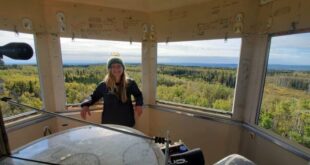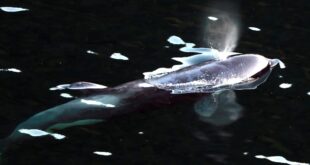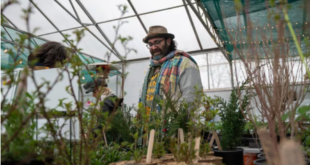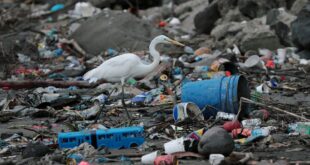Coastal First Nations communities using traditional knowledge to manage Great Bear Rainforest.

The map on Ernie Tallio’s computer screen showed a tangled mess of red lines and dots.
It was late September and Tallio, who manages the Guardian Watchmen program for the Nuxalk First Nation in Bella Coola, B.C., was demonstrating where his team worked the previous summer: travelling the maze of inlets and bays along this rugged coast.
Among their myriad tasks was helping distressed boaters, pulling in crab traps as part of an annual scientific survey and monitoring the coast for illegal fishing and hunting activity.
“We’re the eyes and ears of the nation,” Tallio explained. “It’s important to have our presence out there, on the water.”
The Guardian Watchmen is an Indigenous-led conservation program in the Great Bear Rainforest, a 6.4-million-hectare swath of snow-capped mountains and towering conifers that stretches from central B.C. to the Alaskan panhandle.
The rainforest is known for its “spirit bears,” a subspecies of black bears with a distinctive cream-coloured coat.
Watchmen programs like Tallio’s operate in seven communities along the coast and on Haida Gwaii, employing some 150 local Indigenous people. For Tallio, it’s an important shift from the traditional park ranger model.

“Our youngest [crew member] is 19 years old and the oldest is 55,” he said. “To see them experience the land and how it impacts them on a regular basis — it’s really positive work that we’re doing.”
Unlike park rangers, however, whose salaries are paid for with tax dollars, Guardian Watchmen are partially funded by an unusual source: carbon offsets.
Offsets are a way to “cancel out” greenhouse gases that are spewed into the atmosphere elsewhere. They work by letting emitters (individuals, corporations or governments) fund and take credit for emissions reductions from a project done by another party.
In the case of the Great Bear Rainforest, the carbon offsets are being sold by Coastal First Nations — an alliance of nine First Nations along B.C.’s coast — in exchange for protecting forests that would otherwise have been logged.
It’s a novel way to fund conservation — one that proponents hope could be a model for elsewhere. But to date, offset sales have been slower than expected, raising questions as to whether this unique model is actually sustainable.
Carbon offsets as revenue source
The Great Bear Rainforest is considered one of the biggest carbon sinks in the world, sucking millions of tonnes of carbon dioxide from the atmosphere every year.
The unique funding model was developed as part of an agreement signed in 2016 by Coastal First Nations and the provincial government. Under the agreement, 85 per cent of the rainforest was declared off limits to logging, including 70 per cent of old-growth forests.
“Through those negotiations, carbon offsets became an important opportunity that both the province and First Nations wanted to work towards,” said Paul Kariya, a senior policy analyst with Coastal First Nations.
Selling offsets was seen as a way to counter the economic impact of reduced logging, Kariya said.

“The hope was that the carbon offset revenue would replace that.”
But to date, the annual revenue from carbon offsets has been only half of what had been expected. The B.C. government has been the main buyer, offsetting emissions from its public sector operations, including hospitals and universities.
Roughly $10 million of credits remain unsold each year, however, leaving programs like the Guardian Watchmen at risk.
“It’s fair to say that the shingle was hung out and we were ready for business,” said Kariya. “But it’s not like the world has come knocking on our door.”
Concern about old-growth forests
One of the criticisms of the Great Bear Rainforest carbon offset project is that old-growth logging has continued despite the protection of more forested areas.
“There’s less logging, but it’s the biggest, oldest trees that are now being essentially targeted, because they’re the most valuable,” said Jody Holmes, director of the Rainforest Solutions Project and one of the architects of the Great Bear agreement.
Holmes says the value of carbon offsets is enough to slow second-growth logging, but not enough yet to save old-growth.
Still, she has seen a positive shift in how logging is done in the Great Bear Rainforest. Loggers are leaving bigger buffers along salmon-bearing streams and avoiding steep, unstable slopes, for example.
The biggest change, Holmes says, has been a stronger recognition of First Nations values and culture.
“You have to work with the nations before you go out and do any logging now,” she said.
Lingering skepticism
Public skepticism over the legitimacy of carbon offsets also remains high. Those doubts were fuelled earlier this year by a report that Verra, the world’s largest carbon credit certifier, was issuing “phantom credits” for projects in the Amazon rainforest.
Other factors have made offset sales challenging for the Great Bear initiative as well. Kariya says that around the time the agreement was signed, the carbon offset market was flooded with cheap offsets for projects done elsewhere that lacked proper oversight. The result was a big dip in the price of carbon credits, to as low as $2 US per tonne of greenhouse gas emissions offset (the current price is around $15 per tonne).

Offsets sold by Coastal First Nations, Kariya says, go through a rigorous made-in-B.C. certification process. Each credit also has its own serial number, which is retired after it’s been purchased, to avoid “double counting.”
Most of the Great Bear carbon offsets are currently sold through what’s known as the “voluntary market” — individuals looking to reduce their carbon footprint or corporations that have voluntarily pledged to cut their emissions. The hope, Kariya says, is that more corporations will be required to cut their carbon emissions, which should drive more demand for offsets.
“We expect to see higher prices on the compliance market,” he said, “which will mean more revenue for communities.”
Kariya concedes that the idea of using carbon offsets to fund conservation is still relatively new in Canada. But he’s optimistic it can be a sustainable model — one that could be used for conservation initiatives elsewhere in the country.
Kariya has been promoting the offset program at international events like Climate Week NYC in hopes of drumming up more sales.
“We’re trying to tell our story,” he said. “It’s taken a little while to get going, but it’s starting to take hold and grow.”
For Ernio Tallio with Guardian Watchmen, the funding from carbon offsets hits close to home. His son is now keen to follow in his footsteps, he says. The uncertainty around funding worries him, but he remains hopeful.
“Because of the good work that we’re doing,” Tallio said, “I think we’ll be around for a while.”
ABOUT THE AUTHOR

Brad Badelt is a freelance print and radio journalist based in Vancouver, B.C. When he’s not working on a story, he likes spending time in the great outdoors with his son.
*****
Credit belongs to : www.cbc.ca
 Atin Ito First Filipino Community Newspaper in Ontario
Atin Ito First Filipino Community Newspaper in Ontario






